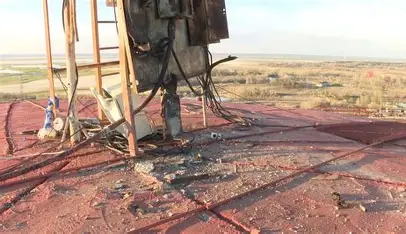Moscow, October 6, 2025 — Large parts of southern and western Russia were left without electricity overnight after Ukraine launched one of its most extensive drone assaults since the start of the war, targeting key energy infrastructure and military sites deep inside Russian territory.
Russian authorities confirmed that multiple regions, including Belgorod, Kursk, and Bryansk, suffered widespread power outages following what they described as a “massive Ukrainian drone attack.” The strikes reportedly hit power substations and fuel depots, causing temporary blackouts that affected thousands of homes and disrupted rail transport in several areas.
The Russian Ministry of Energy said emergency crews were working to restore power but warned that some regions could experience rolling outages for several days due to damage to high-voltage transmission lines. “Repair teams have been deployed, but restoration will take time given the scale of the damage,” the ministry said in a statement.
Ukrainian officials have not officially confirmed responsibility for the attacks, in keeping with Kyiv’s policy of strategic ambiguity regarding operations on Russian soil. However, a senior Ukrainian defense source told Innovation Times that the strikes were part of a coordinated effort to “degrade Russia’s ability to wage war” and disrupt logistics supporting Moscow’s ongoing offensive in eastern Ukraine.
According to reports from Russian state media, more than 70 drones were intercepted overnight across several regions. Still, local governors in Belgorod and Bryansk acknowledged that “several critical targets” were hit despite air defenses. Videos circulating on Russian social media appeared to show large explosions and fires near electrical substations and industrial facilities.
The attack marks an escalation in Ukraine’s campaign to hit Russian infrastructure far beyond the front lines. Over the past few months, Kyiv has intensified long-range drone operations aimed at oil depots, ammunition plants, and energy hubs, seeking to weaken Russia’s war economy.
“The latest wave demonstrates Ukraine’s growing drone capabilities and its determination to bring the war home to Russia,” said Mark Galeotti, a security analyst at Mayak Intelligence in London. “These attacks are symbolic as much as strategic — they remind ordinary Russians that the conflict is no longer confined to Ukrainian territory.”
Russian officials accused Ukraine of “terrorism” and vowed retaliation. Kremlin spokesperson Dmitry Peskov said President Vladimir Putin had been briefed on the situation and ordered security agencies to strengthen air defense systems around critical infrastructure. “The enemy continues to attempt to destabilize our internal situation through sabotage,” Peskov said. “These attacks will not go unpunished.”
In Belgorod, local authorities reported explosions near an oil storage terminal and electrical facilities that supply nearby military bases. In Bryansk, officials said several power transformers were destroyed, knocking out electricity in parts of the city and surrounding villages. Rail services connecting Bryansk to Moscow were temporarily halted as a safety precaution.
Energy analysts say the strikes could have limited but symbolic impact on Russia’s overall power grid. “While local damage can be repaired, the repeated targeting of energy infrastructure forces Russia to divert military resources to defend non-combat zones,” said Dr. Tatiana Orlova, an energy expert at Oxford Economics. “It’s a strategy that drains both manpower and morale.”
Ukraine has developed a growing arsenal of domestically produced long-range drones capable of flying hundreds of kilometers. Western intelligence assessments suggest Kyiv has significantly improved its precision strike capabilities since 2024, using advanced navigation systems and artificial intelligence-assisted targeting.
Meanwhile, Russian social media channels were flooded with videos of drones buzzing over cities as air defense systems lit up the night sky. Residents in Kursk described hearing “a series of loud explosions” and seeing fires on the horizon. “The lights went out suddenly, and we could hear drones for almost an hour,” said one resident in a video posted to Telegram.
The latest barrage comes amid reports that Ukraine is intensifying its counteroffensive operations along multiple fronts while targeting logistics lines that supply Russia’s war effort. Kyiv has repeatedly said that attacks on Russian military and energy assets are a legitimate response to Moscow’s ongoing bombardment of Ukrainian cities.
Western officials have so far refrained from publicly endorsing Ukrainian strikes on Russian territory but have acknowledged Kyiv’s right to self-defense. “Ukraine has every right to disrupt the systems that enable Russia’s aggression,” said a senior European diplomat in Brussels.
As repair teams work to restore power in the affected Russian regions, the attacks highlight the evolving nature of modern warfare — one increasingly dominated by drones and cyber capabilities rather than traditional front-line combat. For now, the drone war between Russia and Ukraine shows no sign of slowing, with each side racing to outpace the other in technology, reach, and impact.



